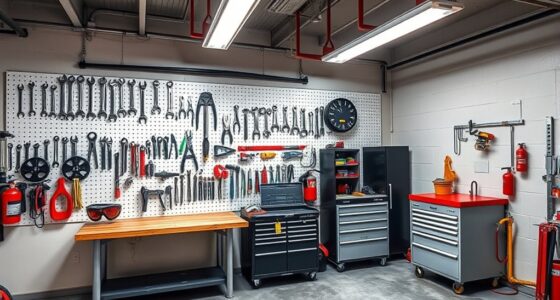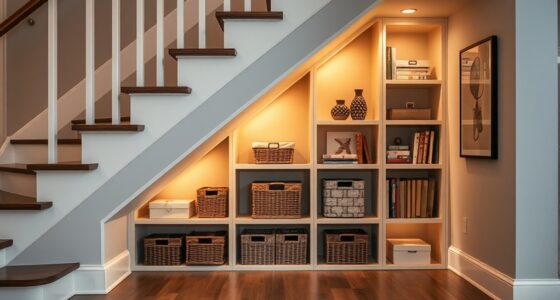To manage your kids’ playroom without sacrificing fun, use clear storage bins, labeled with pictures or words, and create designated zones for different activities like reading or crafts. Encourage your children to put toys away after play and involve them in organizing routines. Incorporate storage furniture that doubles as play space and make cleanup fun with timers or music. Keep the environment engaging and organized—your next steps can make a real difference.
Key Takeaways
- Use clear, labeled storage containers to keep toys organized and easily accessible for children.
- Designate specific zones for different activities to reduce clutter and promote focused play.
- Involve kids in organizing and decluttering routines to foster responsibility and ownership of their space.
- Incorporate multifunctional furniture, like storage ottomans, to maximize space without sacrificing fun.
- Make cleanup fun with timers or music, turning organization into an engaging and routine activity.

A well-organized kids’ playroom can transform chaos into a fun and functional space. When you focus on smart toy storage and clutter control, you create an environment where kids can enjoy their playtime without feeling overwhelmed by mess. The key is to design a system that’s easy for your children to use, encourages responsibility, and keeps everything tidy with minimal effort.
Start by choosing the right toy storage solutions. Bins, baskets, and shelves are your best friends here. Opt for clear containers so your kids can easily see what’s inside, making cleanup quicker and more straightforward. Label each bin or basket with words or pictures to help your children identify where each toy belongs. This not only streamlines the cleanup process but also promotes independence and responsibility. When toys have designated homes, clutter control becomes much more manageable because toys won’t end up scattered across the room or buried under other items.
Use clear, labeled storage bins to make cleanup easier and teach responsibility.
Incorporate storage furniture that doubles as play furniture, like ottomans with built-in compartments or multi-tiered shelves. These pieces maximize space and keep the room feeling open and inviting. Encourage your kids to put toys back into their designated storage after playing, turning clean-up into a routine rather than a chore. Make it fun by setting timers or playing music to motivate quick and efficient tidying.
Implementing a regular decluttering routine also helps maintain a clutter-free space. Every few weeks, go through the toys with your children and ask if they’re still interested in or playing with certain items. Donate or store away toys they’ve outgrown or lost interest in. This prevents accumulation of unused toys that often contribute to clutter, making the room easier to manage. Additionally, teaching children about symptoms of breast cancer and health awareness can be incorporated into educational activities or conversations, promoting overall well-being.
Creating zones within the playroom can also improve organization. Designate specific areas for different activities, like a reading nook, a craft station, or a building corner. This way, toys associated with each activity stay together, reducing the chance of clutter spreading throughout the room. Keeping similar items in one spot helps your kids develop habits of tidiness and makes cleanup faster.
Finally, involve your kids in the organization process. When they help decide where toys go and participate in cleaning up, they learn valuable skills and take ownership of their space. With thoughtful toy storage and clutter control, you’ll turn your playroom into a place that’s not only fun but also easy to maintain, encouraging your children to keep it tidy without sacrificing the joy of play.
Frequently Asked Questions
How Can I Encourage Kids to Keep the Playroom Tidy?
You can encourage your kids to keep the playroom tidy by using effective parenting strategies like setting clear rules and involving them in organizing. Introduce various storage container types, such as bins, baskets, and shelves, to make cleanup easy and fun. Praise their efforts and make tidying up part of the routine. This approach helps instill responsibility while keeping the playroom organized without sacrificing the fun.
What Are the Best Storage Solutions for Small Play Areas?
Think of your small play area as a treasure chest. Use creative storage like under-bed bins, wall-mounted shelves, and stackable bins to maximize space. Space-saving solutions like multi-functional furniture and hanging organizers keep toys accessible and organized. These options transform clutter into clarity, allowing your little explorers to enjoy their playtime without feeling cramped. With smart storage, your playroom becomes a magical space for fun and order.
How Often Should I Organize the Playroom?
You should organize the playroom at least once a month to keep it tidy and fun. Incorporate toy rotation to prevent clutter and keep your kids engaged with different toys. Stick to a cleaning schedule, setting aside specific days for decluttering and tidying up. Regular organization helps maintain a manageable space, encourages responsibility, and ensures your kids can enjoy their play area without feeling overwhelmed by chaos.
How Can I Involve Children in Organizing Their Toys?
Think of yourself as a coach, guiding your kids through the game of organization. Use creative labeling to make sorting fun, like colorful pictures or themed tags. Incorporate parenting tips by involving children in choosing storage solutions and asking them to categorize their toys. This way, they feel responsible and excited, turning cleanup time into a game rather than a chore. Your involvement makes the process engaging and teaches valuable independence.
What Safety Considerations Are Important in Playroom Organization?
You should prioritize safety by checking for playroom fire hazards, such as electrical outlets or cords that could cause fires. Keep choking prevention tips in mind by avoiding small, easily swallowed toys and regularly inspecting toy parts. Secure furniture to walls to prevent tipping, and make certain toys are age-appropriate. Creating clear pathways and using safety gates can also help prevent accidents, making the playroom both fun and safe for your kids.
Conclusion
By gently guiding your playroom’s chaos into a more harmonious space, you create an environment where fun can flourish without overwhelming. With a few simple strategies, you’ll find that managing toys becomes a delightful dance rather than a formidable chore. Embrace the journey toward a tidy, inviting play area—where your kids can explore and imagine freely, all while you enjoy a little more peace amidst the playful paradise you’ve crafted.








